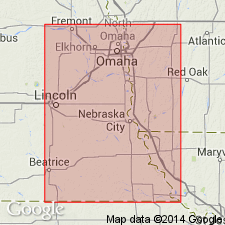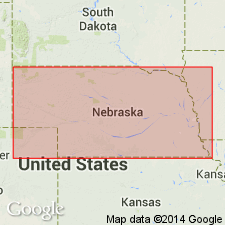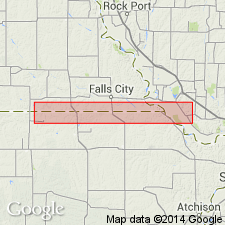
- Usage in publication:
-
- Jones Point shale bed
- Modifications:
-
- Original reference
- Dominant lithology:
-
- Shale
- AAPG geologic province:
-
- Nemaha anticline
Summary:
Pg. 40, 43, 51. Jones Point shale bed of Calhoun shale member of Shawnee formation. Bluish-gray argillaceous to calcareous shale, with some carbonaceous material. Thickness 8 to 10 feet. Is basal bed of Calhoun shale. Overlies Ervine Creek limestone and underlies Meadow limestone. Age is Late Pennsylvanian (Missouri age). Report includes cross sections, measured sections, geologic maps, stratigraphic tables.
Named from Jones Point, a spur in the Missouri River bluffs east of Union, [Cass Co.], southeastern NE.
Source: US geologic names lexicon (USGS Bull. 896, p. 1054-1055); GNC KS-NE Pennsylvanian Corr. Chart, sheet 1, Oct. 1936; supplemental information from GNU records (USGS DDS-6; Denver GNULEX).

- Usage in publication:
-
- Jones Point shale bed
- Modifications:
-
- Contact revised
- AAPG geologic province:
-
- Nemaha anticline
Summary:
Pg. 47. Jones Point shale bed of Calhoun shale member of Shawnee group. Consists of 8.5 feet of shale; the top "zone" is bluish and argillaceous, and the basal "zone" is bluish-gray, bedded to massive, indurated, with many fenestrated bryozoans, CHONETES GRANULIFER, and pelecypods. Stated that true Meadow limestone belongs in Stanton limestone, and he applied Sheldon limestone to the limestone underlying Iowa Point shale and overlying Jones Point shale. Age is Pennsylvanian.
Source: US geologic names lexicon (USGS Bull. 896, p. 1054-1055); GNC KS-NE Pennsylvanian Corr. Chart, sheet 1, Oct. 1936; supplemental information from GNU records (USGS DDS-6; Denver GNULEX).

- Usage in publication:
-
- Jones Point shale member
- Modifications:
-
- Revised
Summary:
Pg. 11. Jones Point shale member of Calhoun shale formation of Shawnee group. Divided Calhoun shale formation into (descending) Iowa Point shale, Sheldon limestone, and Jones Point shale. This classification was adopted by R.C. Moore, Aug. 31, 1936 (Kansas Geol. Survey Bull., no. 22, p. 48), but on p. 187-194 he proposed to redefine Ervine Creek limestone, Jones Point shale, and Sheldon limestone on cyclothem basis. Age is Late Pennsylvanian (Virgil). [See 1936 entry under Sheldon limestone.]
Source: US geologic names lexicon (USGS Bull. 896, p. 1055); GNC KS-NE Pennsylvanian Corr. Chart, sheet 2, Oct. 1936.
For more information, please contact Nancy Stamm, Geologic Names Committee Secretary.
Asterisk (*) indicates published by U.S. Geological Survey authors.
"No current usage" (†) implies that a name has been abandoned or has fallen into disuse. Former usage and, if known, replacement name given in parentheses ( ).
Slash (/) indicates name conflicts with nomenclatural guidelines (CSN, 1933; ACSN, 1961, 1970; NACSN, 1983, 2005, 2021). May be explained within brackets ([ ]).

